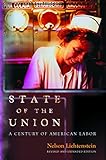State of the Union : A Century of American Labor - Revised and Expanded Edition / Nelson Lichtenstein.
Material type: TextSeries: Politics and Society in Modern America ; 91Publisher: Princeton, NJ : Princeton University Press, [2013]Copyright date: ©2013Description: 1 online resource (400 p.) : 28 halftonesContent type:
TextSeries: Politics and Society in Modern America ; 91Publisher: Princeton, NJ : Princeton University Press, [2013]Copyright date: ©2013Description: 1 online resource (400 p.) : 28 halftonesContent type: - 9780691160276
- 9781400848140
- 331.09730904 23
- online - DeGruyter
- Issued also in print.
| Item type | Current library | Call number | URL | Status | Notes | Barcode | |
|---|---|---|---|---|---|---|---|
 eBook
eBook
|
Biblioteca "Angelicum" Pont. Univ. S.Tommaso d'Aquino Nuvola online | online - DeGruyter (Browse shelf(Opens below)) | Online access | Not for loan (Accesso limitato) | Accesso per gli utenti autorizzati / Access for authorized users | (dgr)9781400848140 |
Browsing Biblioteca "Angelicum" Pont. Univ. S.Tommaso d'Aquino shelves, Shelving location: Nuvola online Close shelf browser (Hides shelf browser)

|

|

|

|

|

|

|
||
| online - DeGruyter Karl Marx : Thoroughly Revised Fifth Edition / | online - DeGruyter Albert Einstein, The Human Side : Glimpses from His Archives / | online - DeGruyter Restoring the Lost Constitution : The Presumption of Liberty - Updated Edition / | online - DeGruyter State of the Union : A Century of American Labor - Revised and Expanded Edition / | online - DeGruyter The Plum in the Golden Vase or, Chin P'ing Mei, Volume Five : The Dissolution / | online - DeGruyter Before and After Muhammad : The First Millennium Refocused / | online - DeGruyter Lobbying America : The Politics of Business from Nixon to NAFTA / |
Frontmatter -- Contents -- Preface To The 2013 Edition -- Preface and Acknowledgments -- Introduction -- Chapter 1. Reconstructing the 1930s -- Chapter 2. Citizenship at Work -- Chapter 3. A Labor-Management Accord? -- Chapter 4. Erosion of the Union Idea -- Chapter 5. Rights Consciousness in the Workplace -- Chapter 6. A Time of Troubles -- Chapter 7. Reorganizing the House of Labor -- Chapter 8. Obama's America: Liberalism without Unions? -- Notes -- Index
restricted access online access with authorization star
http://purl.org/coar/access_right/c_16ec
In a fresh and timely reinterpretation, Nelson Lichtenstein examines how trade unionism has waxed and waned in the nation's political and moral imagination, among both devoted partisans and intransigent foes. From the steel foundry to the burger-grill, from Woodrow Wilson to John Sweeney, from Homestead to Pittston, Lichtenstein weaves together a compelling matrix of ideas, stories, strikes, laws, and people in a streamlined narrative of work and labor in the twentieth century. The "labor question" became a burning issue during the Progressive Era because its solution seemed essential to the survival of American democracy itself. Beginning there, Lichtenstein takes us all the way to the organizing fever of contemporary Los Angeles, where the labor movement stands at the center of the effort to transform millions of new immigrants into alert citizen unionists. He offers an expansive survey of labor's upsurge during the 1930s, when the New Deal put a white, male version of industrial democracy at the heart of U.S. political culture. He debunks the myth of a postwar "management-labor accord" by showing that there was (at most) a limited, unstable truce. Lichtenstein argues that the ideas that had once sustained solidarity and citizenship in the world of work underwent a radical transformation when the rights-centered social movements of the 1960s and 1970s captured the nation's moral imagination. The labor movement was therefore tragically unprepared for the years of Reagan and Clinton: although technological change and a new era of global economics battered the unions, their real failure was one of ideas and political will. Throughout, Lichtenstein argues that labor's most important function, in theory if not always in practice, has been the vitalization of a democratic ethos, at work and in the larger society. To the extent that the unions fuse their purpose with that impulse, they can once again become central to the fate of the republic. State of the Union is an incisive history that tells the story of one of America's defining aspirations. This edition includes a new preface in which Lichtenstein engages with many of those who have offered commentary on State of the Union and evaluates the historical literature that has emerged in the decade since the book's initial publication. He also brings his narrative into the current moment with a final chapter, "Obama's America: Liberalism without Unions.?
Issued also in print.
Mode of access: Internet via World Wide Web.
In English.
Description based on online resource; title from PDF title page (publisher's Web site, viewed 29. Jul 2021)


